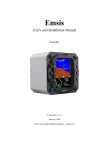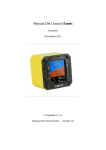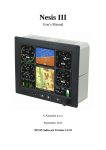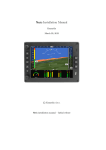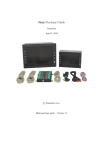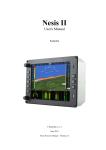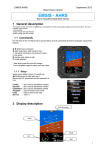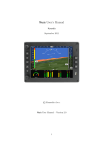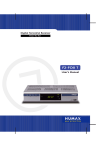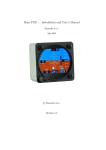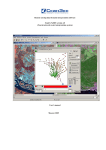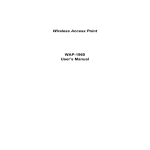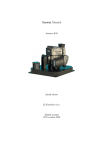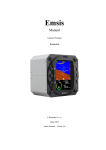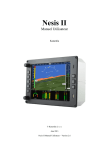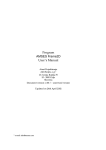Download Emsis Manual
Transcript
EMSIS User's And Installation Manual © Kanardia d. o. o. June 2015 EMSIS User's and Installation Manual – Version 2.12 Contact Information Publisher and producer: Kanardia d.o.o. Ulica heroja Rojška 70 SI-3000 Celje Slovenia Tel: +386 40 360 512 Email: [email protected] A lot of useful and recent information can be also found on the Internet. See http://www.kanardia.eu for more details. Copyright This document is published under the Creative Commons, Attribution-ShareAlike 3.0 Unported license. Full license is available on http://creativecommons.org/licenses/by-sa/3.0/legalcode web page and a bit more human readable summary is given on http://creativecommons.org/licenses/by-sa/3.0/. In short, the license gives you right to copy, reproduce and modify this document if: you cite Kanardia d.o.o. as the author of the original work and you distribute the resulting work only under the same or similar license to this one. Credits This document was written using Microsoft Office (Word) running on Microsoft Windows operating system. Most of the figures were drawn using Open Office Draw and Inkscape applications. Photos and scanned material was processed using Gimp. All document sources are freely available on request under the license mentioned above and can be obtained by e-mail. Please send requests to [email protected]. Revision History The following table shows the revision history of this document. Revision 1.0 2.0 2.6 2.12 Date Nov 2012 Feb 2013 May 2013 June 2015 Description Initial release Added Installation Added Maps Added description of functions accumulated in since version 2.6. Document can be downloaded from Kanardia web site http://www.kanardia.eu/downloads/emsis. Table of Contents 1 INTRODUCTION....................................................................................5 2 EMSIS BASICS......................................................................................5 2.1 Command Panel............................................................................................ 5 2.2 Turning ON/OFF.............................................................................................6 2.3 Updating EMSIS Software..............................................................................6 2.3.1 Downloading Software................................................................................................. 6 2.3.2 Copying New Software into EMSIS...............................................................................7 3 GENERAL INFORMATION ABOUT EMSIS PFD............................................7 4 GENERAL INFORMATION ABOUT EMSIS EMS...........................................8 4.1 Engine Sensors............................................................................................. 9 4.2 CAN Bus....................................................................................................... 9 5 MAIN PAGE...........................................................................................9 5.1 Primary Flight Display Page...........................................................................9 5.1.1 In Flight..................................................................................................................... 10 5.2 Engine Monitoring Page...............................................................................11 5.2.1 In Flight..................................................................................................................... 12 5.3 Maps.......................................................................................................... 12 5.3.1 Maps Zoom Level...................................................................................................... 12 5.3.2 Map Option Activation............................................................................................... 13 5.3.3 Copy Maps................................................................................................................. 13 5.3.4 Delete Maps.............................................................................................................. 14 5.3.5 Info About Maps......................................................................................................... 14 5.3.6 Maps Settings............................................................................................................ 14 6 EMSIS SETUP PAGE.............................................................................14 6.1 Logbook..................................................................................................... 15 6.1.1 PDF Mode.................................................................................................................. 15 6.1.2 EMS Model................................................................................................................. 16 6.2 Engine........................................................................................................ 16 6.2.1 Engine Type............................................................................................................... 16 6.2.2 Sensors...................................................................................................................... 16 6.3 Tank........................................................................................................... 18 6.3.1 Tank Shape................................................................................................................ 19 6.3.2 Tank Min/Max............................................................................................................. 20 6.4 Brightness.................................................................................................. 20 6.5 Airspeed..................................................................................................... 21 6.6 Units.......................................................................................................... 21 6.7 Pilots.......................................................................................................... 22 6.8 Maps.......................................................................................................... 22 6.9 Service....................................................................................................... 22 6.9.1 Layout....................................................................................................................... 23 6.9.2 AHRS Level................................................................................................................ 23 6.9.3 Compass Calibration.................................................................................................. 24 6.9.4 Compass Offset......................................................................................................... 24 6.9.5 Firmware Update....................................................................................................... 25 6.9.6 RamBoot Update....................................................................................................... 25 6.9.7 Logger Settings......................................................................................................... 25 6.9.8 Up/Down.................................................................................................................... 25 6.9.9 Set Alt & IAS Offset.................................................................................................... 26 6.9.10 Set MAP & Fuel Flow Offset......................................................................................26 6.10 About....................................................................................................... 26 7 INSTALLATION....................................................................................27 7.1 Installation to the Instrument Panel.............................................................27 7.1.1 EMSIS Back Panel Connectors and Cable Clearance..................................................27 7.2 Connection to the Electrical System.............................................................28 7.3 Pitot-Static Connection................................................................................29 7.4 Outside Air Temperature Probe Installation..................................................29 7.5 Connection to the CAN Network...................................................................30 7.6 Connection to the 485 Network....................................................................30 7.7 GPS Antenna Installation.............................................................................30 EMSIS – User’s and Installation Manual 1 Introduction First of all, we would like to thank you for purchasing our product. The EMSIS system is a set of complex electronics devices and we strongly recommend to carefully read this manual before installing and using EMSIS system. EMSIS is a name for a line of flight instruments which can be used as: primary flight display (PFD), engine monitoring system (EMS). or both. The introduction chapter contains some general information about the instrument and its operation. Later chapters describe EMSIS use and reveal the details. 2 EMSIS Basics This chapter describes the organization of the EMSIS instrument. It teaches you about the individual buttons and their meaning. After reading it, you will be familiar with basic EMSIS operations. 2.1 Command Panel EMSIS instruments come in two physical sizes. The first one is a standard aviation size, which is 80 mm diagonal, while the second one is non-standard and is characterized with a 3.5" screen diagonal. The EMSIS command panel is organized according to Figure 1. It uses six (80 mm version) or five (3.5" screen version) small push buttons to manipulate the user interface. Additionally, it has SD card slot for software, maps and data updates. Here is a brief description of individual items: 1. The up arrow button is used to move the menu selection, to change a value or a letter within active control or some other page special function. 2. The check button confirms selection and can be also viewed as an OK button. 3. The down arrow button does the same as the up arrow button, just in a reverse direction. 4. The power ON/OFF button is normally not used. However on some EMSIS instruments, it is used to turn the instrument on/off. Note that 3.5" screen EMSIS does not have the power ON/OFF button. 5. The cross button serves as the close command and can be also viewed as cancel button. 6. The page selector button is used to switch between pages (screens). 7. SD card slot is used for software, maps and data updates. 5 EMSIS – User’s and Installation Manual 2 5 6 3 7 1 7 1 4 2 5 3 6 Figure 1: Organization of EMSIS front panel. EMSIS 80 mm version (left), EMSIS 3.5" screen version (right). 2.2 Turning ON/OFF EMSIS is connected to the avionics power bus, therefore the instrument normally turns on as soon as the avionics is switched on and a couple of seconds later, it is ready for the operation. This is the default behaviour. However, in some situations, the behaviour mentioned above is not suitable. In this case you can order a special version1, which can be switched on or off using the power button. Please note that a minor hardware modification is required. This must be done in factory. 2.3 Updating EMSIS Software The EMSIS software is under constant development and if you want to keep your EMSIS up to date, you should update your EMSIS regularly. This section describes actions required to update the software. The update for EMSIS is performed in two steps: downloading new software, copying new software into EMSIS. 2.3.1 Downloading Software The software updates are located in the EMSIS/Updates section of our web site; http://www.kanardia.eu/downloads/emsis. Click on the update file and save it to a hard drive of your PC. The update file name is Update.kus. Never change the name of the file. This file must be copied on SD card, more precisely into the base (root) folder of the card. Once file was copied, please make sure to safely remove SD card from PC. EMSIS software versions 2.4 and earlier support only micro SD cards with capacity 2 GB or less. Later versions also recognise HDSD cards with a higher capacity. 1 Typical use of this option is in a glider. 6 EMSIS – User’s and Installation Manual Please make sure that SD card is formatted as FAT 32 file system. Other file systems will not be recognised by EMSIS. 2.3.2 Copying New Software into EMSIS To copy the software from the SD card into EMSIS follow these steps: 1. Insert SD card with the new software (Update.kus) into EMSIS SD card slot with contacts facing up. 2. Push and hold the down2 button and turn EMSIS ON. A window similar to Figure 2 appears. Figure 2: Boot options window. 3. Use the up and down button to select the Update option and press the check button. Update process will begin. 4. Once finished, EMSIS will start with the new software. The very first start after the update takes slightly longer. The start normally option is used if you changed your mind and you do not want to update the instrument, while the system reset option is used only in emergency and should never be used in normal operation. This option asks for special password in order to protect it from accidental use. 3 General Information about EMSIS PFD EMSIS PFD consists of electronic units which work closely together to bring flight information onto graphical display. The system consists of the following electronic components: Airu (AD-AHRS and GPS unit) – hereinafter referred to as AHRS unit – is an inertial navigation unit aided by the GPS and pressure sensors. AHRS provides attitude, position and velocities. AHRS unit is hidden inside EMSIS PFD unit. EMSIS unit – presents all relevant information that appears on the CAN bus in a pilot friendly form on LCD screen. Most of this manual describes how to access, read and interact with the EMSIS display. EMSIS PFD unit uses state of the art MEMS 3 sensors to read various physical quantities. Since all sensors are solid state, it has no moving parts. This means it has fewer problems with fatigue and ageing. The following MEMS sensors are used in the EMSIS PFD system: The angular rate sensors, also known as gyros, are used in the attitude calculation. The angular rates are integrated in time in order to predict new attitude from the old one. We could say that they give short-time attitude prediction. They are also used in gravity vector calculation. 2 In the case of EMSIS 3.5”, you need to push and hold the up arrow. 3 MEMS - micro-electromechanical systems, a.k.a micro machines, a.k.a micro systems technology. 7 EMSIS – User’s and Installation Manual The acceleration sensors are measuring apparent gravity vector. The true gravity vector is calculated assuming coordinated flight and readings from the other sensors (velocity and angular rate sensors). The ball slip indicator is directly obtained from the acceleration sensors. The absolute pressure sensor is used to calculate altitude and vertical velocity (vario). The differential pressure sensor provides indicated airspeed (IAS). When it is coupled with the outside air temperature (OAT) sensor, it also calculates true air speed (TAS). Assuming coordinated flight, we calculate the referencing attitude from the gravity vector and heading. These values are then compared with the short-term prediction of the attitude. Non-linear Kalman filters are used to combine the short-term prediction and referencing attitude solution into one most probable solution. This is what you see on the attitude indicator. In a very similar way, short-term inertial position prediction is compared with the GPS position. Again, Kalman filtering is used to obtain the final solution. When engine monitoring unit (DAQU) is present on CAN bus, EMSIS PFD can also show relevant engine and fuel information. When maps are enabled and licensed, EMSIS PFD can also show raster maps on graphical display. Further chapters reveal the details. 4 General Information about EMSIS EMS EMSIS EMS consists of electronic units which work closely together to bring engine and fuel information onto graphical display. The system is presented on Figure 3. The system consists of the following electronic components: Engine monitoring unit (DAQU) is used to connect the engine, fuel and electric sensors. EMSIS EMS unit presents all relevant information that appears on the CAN bus in a pilot friendly form on LCD screen. Most of this manual describes how to access, read and interact with the EMSIS display. Figure 3: Illustration of EMSIS EMS configuration. When AHRS unit is present on CAN bus, EMSIS EMS can also show flight information on graphical display, too. When maps are enabled and licensed and AHRS unit is present on CAN bus, EMSIS EMS can also show raster maps on graphical display. Further chapters reveal the details. 8 EMSIS – User’s and Installation Manual 4.1 Engine Sensors Engine related sensors are connected to the engine monitoring unit (DAQU). DAQU unit is designed to be installed on the engine side of the firewall. This has two advantages: Since the unit is close to the engine all cables are short and no extensions are needed. This means less weight and makes installation simpler. We need only one tiny hole through the firewall for the CAN bus cable. The cable transfers all the information and provides the power supply for DAQU unit. DAQU unit is designed to monitor engine sensors for various engines such as Rotax, Rotax iS, D-motor, Jabiru, UL-Power, Lycoming, Continetal, Simonini, Hirth etc. When an engine is equipped with proper sensors, it can measure engine RPM, cylinder head temperature (CHT), exhaust gas temperature (EGT), oil pressure, oil temperature, fuel pressure, fuel flow, fuel level, manifold pressure, carburettor air temperature, voltage, battery current, alternator current, coolant temperature and more. We often add new functions on request of our customers (E.g. lambda, oil flow, etc.) In the case of gyroplane or helicopter installation, it also reads the rotor RPM sensor and sometimes pneumatic pressures. The results of all these measurements are then transmitted on the CAN bus, where all other units are able to access them. More about DAQU unit and engine sensors is written in DAQU Installation Manual. 4.2 CAN Bus The EMSIS system can be easily extended into a much more complex form, shown on Figure 4. We achieved this by introducing CAN bus for the communication between the units. The CAN bus does the magic of the all possible known and unknown future extensions. Imagine the CAN bus as a kind of computer network. Just like new computers can be easily connected to the network, we connect all new devices to CAN. This allows introduction of secondary EMSIS unit, electronic compass (MAGU), pilot command stick, etc. Emsis CAN bus Secondary Emsis Electronic Compass Pilot Stick Special Devices Figure 4: Illustration of EMSIS configuration using CAN bus. 5 Main Page The EMSIS unit can toggle between several different main screens depending on your EMSIS type: • • • • Primary flight display (PFD) screen – artificial horizon with air data. Engine monitoring screen – relevant engine and fuel information, more than one screen is also possible. Maps screen – graphical display of raster maps. EMSIS setup – used to change different settings and options. 5.1 Primary Flight Display Page The Primary flight display page is illustrated on Figure 5. It is an artificial horizon with the flight data 9 EMSIS – User’s and Installation Manual information. 1 12 1 2 3 4 14 11 13 10 9 5 6 7 8 Figure 5: EMSIS primary flight display page. The page consists of the following items: 1. Quality of the GPS fix. Three green bars mean 3D fix, two yellow bars are 2D fix and cross means no signal from GPS. 2. Ground speed from GPS. 3. Direction. It can be GPS track (active only when ground speed is over 20 km/h). In this case you will see “g” extension. When Magu (magnetic compass) is present, then it will show true heading with the “t” extension. 4. True air speed. 5. Vertical speed indicator (vario) scale. 6. Vario label displays current value of the vertical speed. 7. Baro corrected altitude value. 8. Current QNH setting (baro-correction). 9. Indicated airspeed (IAS). 10. The inclinometer (slip-skid) indicator. 11. Outside air temperature (OAT). 12. Wind indication. Arrow shows relative direction regarding to the flight line. Below arrow you see windspeed. Magnetic compass (Magu) is required to see these values. 13. Artificial horizon with roll and pitch indications. 14. The turning rate scale. Inner points indicate one minute turn (6 degrees per second) while outer points indicate 30 seconds turn (12 degrees per second). 5.1.1 In Flight While in flight, two options can be set: Push and hold up button sets current pitch, see Figure 6. It will take current pitch and set it as a zero pitch. The change is not immediate and it takes cca 5 sec for AHRS unit to accept it. Once EMSIS is switch off, this setting is forgotten. 10 EMSIS – User’s and Installation Manual Figure 6: Setting pitch. Up and down button sets brightness or QNH, depending of settings, see 6.9.8 Up/Down. Long press on the page selector button (see Figure 1, button 6) opens the fuel quantity window. This window accessible only when no fuel level sensors are connected and thus a software fuel tank is provided. 5.2 Engine Monitoring Page An example of engine monitoring page is illustrated on Figure 7. It can be designed differently for each EMSIS unit regarding to the wishes of the customer. Additionally, more than one EMS page can be configured. 1 1 2 3 14 13 12 11 10 9 4 5 8 7 6 Figure 7: EMSIS engine monitoring page. The page from Figure 7 shows the following items: 1. engine RPM indicator, 2. airbox temperature, 3. manifold pressure, 4. fuel level with the numeric indication, 5. fuel consumption (fuel flow), 6. engine total time, 7. ampere meter (electrical current meter), 8. system voltage, 9. water temperature, 10. CHT with two sensors and the largest value of both, 11. EGT with several sensors and the largest value of them all, 12. oil temperature, 13. fuel pressure, 14. oil pressure. 11 EMSIS – User’s and Installation Manual This is just a subset of options. EMSIS can also display: rotor RPM, pneumatic pressure, trim positions, gearbox temperature, carburettor temperature and much more. Additionally, the engine parameters can be mixed with flight parameters. So, you can see the altitude, airspeed, QNH, etc. as well. Figure 8: A few more examples of EMSIS engine monitoring page. 5.2.1 In Flight While in flight, two options can be set: Push and hold the up button sets current pitch, see Figure 6. Up and down button sets brightness or QNH, depending of settings, see 6.9.8 Up/Down. Long press on the page selector button (see Figure 1, button 6) opens the fuel quantity window. This window accessible only when no fuel level sensors are connected and thus a software fuel tank is provided. 5.3 Maps The maps page is illustrated on Figure 9. Maps can be shown on EMSIS only if GPS information is present on the CAN bus. EMSIS PDF supports this by default, while other versions depend on units that are connected to the CAN bus (Nesis, some other EMSIS PDF, Horis, etc.). Maps options are not enabled by default. This option must be purchased. The best moment for this is at the time of the order of instrument. However, this can be done later as well. EMSIS can show raster maps, which must be copied to its internal memory first. Currently we have limited raster maps support. In future more countries will be supported. Please visit our web site for more details. For your convenience, EMSIS unit is usually shipped with pre-copied maps. Some of these maps are licensed and they require a valid license file. Please contact Kanardia or our representative in order to obtain the license file. 5.3.1 Maps Zoom Level EMSIS unit keeps updating several different moving map zoom levels. These levels are seamlessly computed in the background and are immediately available. The only exception is the start-up, when EMSIS unit needs some time to prepare the initial maps. Zoom levels are changed with up and down button. 12 EMSIS – User’s and Installation Manual Figure 9: EMSIS maps page. 5.3.2 Map Option Activation If you purchased the map option after the instrument was delivered, you need to activate this option manually. In this case you need to obtain the activation password from Kanardia. The password is bound to the serial number of the instrument. The procedure is as follows: • Write down the serial number of your EMSIS. The serial number is displayed on the Setup|About window. • Email this serial number to Kanardia or to our representative. • We will calculate the activation password and email it back to you either directly or over the representative. • Enter this password using the Setup page, Maps|Enable Maps window. The password usually consists of digits and letters. EMSIS does not distinguish between uppercase or lowercase. • EMSIS restarts and the Map page appears. The activation is stored on the chip and is valid for the lifetime of the instrument. 5.3.3 Copy Maps In order to copy a new map into the EMSIS, you need to obtain this map from our web site. Copy this map to the micro SD card that you received with the instrument. (You may use other micro SD cards as well.) Do not put the maps into folders. It is very important that you use “safely remove” option on your PC before you remove the card from it. Once you have a map on the micro SD card, do the following: • Insert the SD card into EMSIS with the contacts facing up. • Select the Setup page, Maps|Copy Maps option. • If asked, enter standard password 314. • A list of the maps on the SD card appears. Select a map you want to copy and press the check button. • Copy procedure commences. Copying is very slow in EMSIS. A large file may take a few hours to copy. Please make sure the batteries are full before you begin. Copying is finished when the red progress bar turns into green. Please note that it may take some time before the progress bar appears. Some proprietary maps require special license file for the final activation. The same copy principle is used for them, too. Figure 10 Shows an example of map copying. 13 EMSIS – User’s and Installation Manual Figure 10: Copying maps (left) and maps info window (right). 5.3.4 Delete Maps It is wise to remove unused maps from the system. This speeds up initial map loading procedure. • Select the Setup page and chose Maps|Delete maps option. • A list of maps appears. Select the map you want to delete and press the check button. This removes the map from internal memory. 5.3.5 Info About Maps In order to see which maps are loaded into EMSIS internal memory, select the Setup page, Maps|Maps Info option. A list of maps appears. If you have a lot of maps loaded, there may be a delay. The list also shows if map is accessible or not. Maps with a red “Lic.” text, are loaded, but not accessible – they are missing a valid license file. Figure 10 shows a valid DFS map of Austria and a loaded but invalid map of Hungary, for example. 5.3.6 Maps Settings The Map page can be additionally configured to show some navigational information on the top and/or on the bottom of the Map page. One top line and two bottom lines can be configured with the following items: IAS, TAS, GS, altitude, tracking, time, UTC, RPM, Rotor RPM. 6 EMSIS Setup Page The EMSIS Setup page allows you to access or set several options. It is accessed by pushing the page selector button. Figure 11 illustrates the page. The displayed options depend on the hardware detected on the CAN bus. Thus, EMSIS EMS version does not show the same options as EMSIS PFD version. The following options are available: Logbook – is used to access the logbook entries. Engine – configures the engine related settings and sensors connected to the engine monitoring unit (DAQU)4 - EMS only. Tank – opens menu for the fuel level measuring hardware and for the fuel tank shape calibration 4 or shows the software tank quantity, if the sensors are not present. EMS only. 4Engine monitoring unit (DAQU) is required. 14 EMSIS – User’s and Installation Manual Units – is used to change the units of individual parameter groups. Pilots – is used to enter pilots. The pilot names are used in logbook. PFD only. Maps – is used to perform various activities with the maps. PFD only. Service – is a gateway to the service specific settings. About – displays information about software and hardware version. Figure 11: The EMSIS setup page. All options are not visible. Some user options are not shown on secondary EMSIS, some options require password entry before proceeding and some options are available only when correct hardware is detected. The factory password is 314, first three most significant digits of number π as seen on Figure 12. The password was introduced in order to prevent unwanted accidental alterations of important settings. The password cannot be changed. Figure 12: EMSIS password is required in order to access certain options. 6.1 Logbook The logbook window allows you to get some information about your flights. The logbook view differs regarding between PFD and EMS mode. 6.1.1 PDF Mode The logbook window list recent flights in reverse order (last flight is listed first). Date, pilot, takeoff time, landing time and duration are shown on each item. Selecting an item and pressing the check button, gives further options: • Details – open a new window with even more details about the selected flight. Use up/down button to scroll the details window. • Copy KML – creates a file on the external SD card in the KML format. This format can be viewed in the Google Earth, for example. It will show you the flight path with the altitude. • Copy TAB – creates a special log file, where entries are separated by tabulator character. Each row in a such file represents one second of flight. Almost all flight and engine parameters are included 15 EMSIS – User’s and Installation Manual in the file. This file can be then imported with Excel or Calc or some other spreadsheet application for further analysis. 6.1.2 EMS Model The EMS model also provide some limited logbook functions. In this case most recent engine runs (engine start, engine stop pairs) are listed. They list items are based on the engine total time. Selecting one of the listed items and pressing the check buttons, performs the Copy TAB action – a special log file will be created on the external SD card. 6.2 Engine The Engine menu from the Setup page gives two options: engine type selection and sensor configuration. 6.2.1 Engine Type Depending on specifications of your aircraft, select the correct engine. Figure 13 shows the engine selection window. Setting the engine type allows EMSIS to calculate fuel consumption and has no other effect on the instrument. Figure 13: Engine type selection window. Available engines are: Generic Rotax 582 65 – two stroke 65 HP Rotax engine. Rotax 912 80 – four stroke 80 HP Rotax engine. Rotax 912 80A – an alternative model for four stroke 80 HP Rotax engine. Rotax 912 100 – four stroke 100 HP Rotax engine. Rotax 912 100A – an alternative model for four stroke 100 HP Rotax engine. Rotax 912 iS – iS or iS Sport. Rotax 914 – 115 HP turbocharged version of Rotax engine. Jabiru 2200 – four cylinder Jabiru engine. Jabiru 3300 – six cylinder Jabiru engine. 6.2.2 Sensors The sensor page is used to configure channels on Daqu. For each channel we define its function, sensor type and some specific parameters. The channel page is illustrated on Figure 14. By the function we mean what this channel is meant for: e.g: Engine RPM, Fuel flow, Oil pressure, EGT, etc. By sensor type we tell which sensor is connected to that channel. Close to 100 different sensors are supported by Daqu and this number is still growing. By “specific parameters” we mean some general or some sensor/channel specific arguments that must also be provided. 16 EMSIS – User’s and Installation Manual Figure 14: List of sensors connected to DAQU unit. Each row in the table corresponds to one DAQU channel. Channels are labelled as combination of one capital letter and one number. Letter defines the channel type, while the number enumerates channels of each type. Four channel types are used in DAQU: • A: analog channels with –2.5 V to +2.5 V input, which are typically used to connect resistive sensors and thermocouples. • B: analog channels with 0 to +5 V input, used to read active sensors. Active sensors require power in order to operate properly. • C: analog channel with 0 to +30 V input, used to read higher voltage levels. • Z: digital channels, used to measure time between pulses. Please refer to the DAQU Manual for more details. After sensors are connected to the DAQU unit, each sensor needs to be configured. Select the appropriable channel from the list by using up and down button and confirm selection by pushing the check button. Window illustrated on Figure 15 opens. Figure 15: Window for setting a sensor on DAQU channel. To change the specifications, follow the next procedure: 1. with up and down button select item you want to change and press the check button, 2. select the value using up and down button and press the check button to confirm, 3. press the cross button to close the window, changes are saved automatically. 17 EMSIS – User’s and Installation Manual 6.3 Tank Depending on Daqu channel configuration and EMSIS layout, tank can be provided in two forms: • • software tank – tank simulation, true hardware tanks – real measurements from sensors. Software Tank Software tank is active, when no “fuel level” channel is configured in Daqu. EMSIS allows you to enter the current amount of fuel and this amount is then reduced in time based on fuel consumption. The fuel consumption is either calculated or measured. Measured fuel consumption usually gives better results, when high quality fuel flow sensors are applied. When fuel flow sensors are not applied, then the fuel flow is calculated based on the engine type. As you can see, the fuel level of software tank is highly subjective and depends on: • • initial estimate of fuel quantity, precision of the fuel flow sensor or precision of the fuel flow mathematical model. Furthermore, any error in fuel flow will sum up in time resulting in a significant error in fuel level indication. This means that software tank level indication must be accepted with a scepticism and the pilot should not rely only on this indication. When software tank is active, selecting the tank option displays the Set fuel window. Use the up and down buttons to adjust the fuel level. Alternatively, you can long press on the pager button. This shows the same window. Figure 16: Software (simulated) fuel tank level adjustment window. Hardware Tank Here, sensors are used to indicate the fuel quantity. First you need to connect sensors to the Daqu and activate/configure the appropriated channels. Once this is done, you can continue with the tank configuration. For each tank a shape of the tank and its min/max value must be configured. When selecting option Tank, a window illustrated on Figure 17 opens. T2 options are shown only if the second fuel level channel is also active. Figure 17: Tank configuration options. 18 EMSIS – User’s and Installation Manual When doing the initial tank setup, selecting a shape is the first step. 6.3.1 Tank Shape Tank shape selection is made in a window shown on Figure 18. Select correct shape for your aircraft tank. The graphics below shows the non-linearity of the tank. Straight diagonal line indicates that the tank is linear. Figure 18: Tank shape selection window. The figure shows that the curve for the Dynamic WT9 tank is very non-linear Custom shape If none fits your aircraft specifications, select shape with “Linear” tank and press and hold the down button button. This opens a special tank shape editor, shown on the Figure 19. The editor is used to add, remove or edit the points that define the tank shape. Each point consist of actual volume of fuel in tank and appropriate sensors readings. At the bottom of the window, you can see actual value measured by sensor. The value shown depends on sensor type. If the sensor is a resistive one, then the value shows resistance and if the sensor is active (capacitive) then you see voltage. Figure 19: Tank editor window – allows you to define the curve of the tank. We recommend the following procedure for the custom shape tanks: 1. Make sure that sensors are configured and that they are working. A good indication is a number at the bottom of the tank edit window. This number must be alive. 2. Make sure the tank is empty and make sure the aircraft is level as it will be in the flight. 3. Delete all tank points so that you have an empty table. 4. Slowly pour fuel into the tank until the sensor number starts changing. Stop at this point. This is 19 EMSIS – User’s and Installation Manual the point where sensor starts detecting fuel. Remember the fuel quantity needed to reach this point – you can consider this as a special reserve. Add the first point with the volume value 0 and the appropriate sensors reading. (Press the check button, select Add and adjust the volume and sensor value). 5. Pour a known quantity of fuel (say 5 or 10 litres). Once the sensor value stabilizes, use Add option to add a new point. The volume numbers must be increasing, while the sensor number may be either always increasing or always decreasing. 6. Repeat this procedure until the tank is full. In most cases, the sensor stops moving before the tank is full. It is important that you do not enter points that have the same (or almost the same) sensor values. We recommend that you modify (Edit) this last point so that it shows the value for the full tank. We also recommend that you are taking notes on the paper – write down all the volume/sensor pairs before you add these pairs into the table. This comes handy, if you accidentally delete a point or you terminate the procedure. Editing the tank automatically performs the min/max calibration as well. Hint: While editing a number, you can use the page selector button to delete the highlighted character. 6.3.2 Tank Min/Max The min/max calibration is necessary, when you select one of the known tank shapes. The system now knows the shape but it does not know the minimal and maximal value of the sensor. This is made in T min/max window shown on Figure 20. Minimum: Make sure that the tank of the aircraft is empty and sensor is connected to DAQU unit. In the Sens row you can observe the sensor current value. When Min is selected press and hold the check button to write the sensor value into EMSIS automatically. Value can be also set manually by pushing check button and entering the desired value with up and down buttons. Figure 20: Window for setting the tank minimum and maximum values. Maximum: Do the same as for minimum, but make sure that the tank is full and Max option is selected. Cross button closes the dialogue and saves inserted values. Note that it is not possible to exit without saving new values into DAQU unit. If you do not want to save new values, the only possibility is to switch the EMSIS unit OFF. 6.4 Brightness The brightness option is visible only when default action for up/down buttons is set to QNH. This is typically for EMSIS PFD. 20 EMSIS – User’s and Installation Manual Select the option and use up/down buttons to adjust the brightness. Note, EMSIS always starts with maximal brightness. 6.5 Airspeed The Airspeed configuration is accessible by selecting the Airspeed option 5 from the Settings page. A window shown on Figure 21 opens. Figure 21: Airspeed configuration window. Change can be done for five scale limits as seen on Figure 22: 1. Low – is the beginning of the scale. The scale shows nothing until the aircraft exceeds this speed limit – only numerical value is seen. 2. Yellow1 – to this limit the range is yellow. Yellow1 range is optional. 3. Green – the maximum value for the green range. Green range is the normal range of the operating speeds for the aircraft. 4. Yellow2 – to this limit the range is yellow. The second yellow range is the range, in which the aircraft may be operated in smooth air, and then only with caution to avoid abrupt control movement. 5. Red – to this limit the range is red – also the end of the scale. Beginning of the red range indicates the maximum demonstrated safe airspeed that aircraft must not exceed under any circumstances (VNE). Figure 22: Example of an airspeed scale. 6.6 Units Units configuration is accessible by selecting the Units option from the Settings page. A window illustrated on Figure 23 opens. 5Not available for all layouts. Some layouts have predetermined speed ranges. 21 EMSIS – User’s and Installation Manual Figure 23: List of configurable units in EMSIS unit. EMSIS uses several units for different physical quantities like distance, velocity, mass, volume, etc. Table 1 shows available units. Physical quantity Available Units Distance (length) nm, sm, km Speed (velocity) km/h, kts, mph Vario (vertical velocity) m/s, ft/min, kts Altitude (length) meter, feet QNH (pressure) hPa, inHg Mass kg, lbs. Temperature C, F Pressure (used in engine) bar, psi Volume l, US gal Flow l/h, gal/h Table 1: Available units for individual physical quantity. 6.7 Pilots The EMSIS PFD version allows you to enter several pilots who typically fly the aircraft. You can create a new pilot, edit an existing one or remove one. Each pilot has a name and optional instructor rating. A pilot, who is also an instructor can act in two roles. It can be either a normal pilot, when flies as PIC or as an instructor, when flies in this role. If more than one pilot is entered into EMSIS, it will ask you to select one on the startup and if there is at least one instructor, it will also ask you for instructor. This information is then used in logbook. 6.8 Maps Please refer to section section 5.3 Maps starting on page 12. 6.9 Service The Service menu opens a window illustrated on Figure 24. It always asks for password. You have to enter standard password 314. 22 EMSIS – User’s and Installation Manual Figure 24: EMSIS Service menu. There are many options displayed here. Some of them depend on the hardware, which is present on the CAN bus: Layout: Allows you to change the configuration layout. Normally, you do not need to change this. AHRS level configuration – used to define the “zero” for the AHRS, Compass calibration – used to calibrate the MAGU (magnetic compass), Compass offset – used to make fine adjustment of MAGU, Firmware update – used to update the software in Daqu, Airu, Magu, RamBoot update – used to update the initial boot software, Logger settings – used to define some logger settings, Up/down – used to define default behaviour of up/down buttons Set alt & IAS offset – used to adjust the zero for the altitude and airspeed sensors, Set MAP & FF offset – used to adjust the manifold pressure and to set a fuel flow factor. 6.9.1 Layout In most cases the correct layout is set in the factory and you do not need to change it unless we advise you to do so. Figure 25 shows a window for selecting a layout. Figure 25: Window for setting EMSIS layout. When dialogue is opened: use up and down button to change layout and confirm with the check button, push the cross button to save and exit the window. EMSIS will restart. 6.9.2 AHRS Level During the assembly of the AHRS unit into the EMSIS unit and during the installation of the EMSIS unit into the instrument panel, a small misalignment may appear. This means that internal axes of the AHRS unit are not parallel to the airplane axes – the AHRS unit is slightly rotated. Such misalignment can be perfectly adjusted without loss of precision using the procedure described next. 23 EMSIS – User’s and Installation Manual Please make sure that airplane is level for both, roll and pitch. Make also sure that EMSIS unit is turned ON for at least five minutes – this warms up the internal electronics and stabilizes numerical filters. Once the airplane is level and steady, select the AHRS level option to start the automatic calibration procedure. Window illustrated on Figure 26 opens. Figure 26: Calibrating the AHRS level. Wait for the progress bar to finish and observe the roll and pitch numerical values. At the end they should be close to zero. Close the window. This also stores new values. 6.9.3 Compass Calibration This option is available only when MAGU (electronic magnetic compass) is also present on the CAN bus. Before you do the calibration, you need to finish the AHRS calibration. Compass and AHRS work in pair and information from AHRS greatly increases the precision of compass. Please, also make sure that the system is running at least for 15 minutes. This time is required to warm up the electronic and stabilize the numerical filters. Figure 27: Calibrating Magu, situation before rotating (left) and after full rotation (right). When ready, you need to rotate the aircraft for cca 400 degrees. Direction of rotation and start azimuth are not important. When rotating, try to keep a steady pace for the best results – this will result in a constant angular velocity. When turning aircraft, the progress bar grows and the procedure is complete when it reaches full. You have to make more than a full circle because the initial readings are not used in computation. At this point a blue ellipse is drawn on the chart. Corrections up to 15 degrees are generally accepted as appropriate. If you constantly get correction curve larger than 15-20 degrees, then you probably need to find a better location for Magu. The correction on Figure 27 reaches cca 8 degrees. Important: If you are happy with the results, you must close the window using the check button. This will also save the results. Closing with the cross button does not save the results. 6.9.4 Compass Offset The procedure mentioned above removes most of the compass error and in most cases this is more than enough. However, some constant error in all direction remains. You need to obtain this error by observing 24 EMSIS – User’s and Installation Manual difference between known reference magnetic headings and by the headings shown on the window. This error is more or less constant regardless to the direction. Write down this difference for a few different directions and calculate the average. Enter this final correction using the Compass Offset option. When the compass readings were too large, enter negative value and vice versa. Figure 28: Compass offset window – final adjustment of compass. 6.9.5 Firmware Update This command updates the software of devices present on the CAN bus: AD-AHRS module (Airu), EMS module (Daqu), compass module (Magu), etc. Do not use this function unless we advise you to do so. 6.9.6 RamBoot Update This command updates the startup software, which takes care for the instrument start. Do not use this function unless we advise you to do so. 6.9.7 Logger Settings Here we can tune some logger specific parameters. These parameters are used to identify conditions for the take-off, landing and engine start/stop. • • • • Take-off threshold specifies IAS, which must be exceeded for a few seconds for a logger to detect and record a take-off event. Landing threshold specifies IAS, which must be kept below for a few seconds in order to detect the landing event. This also works in conjunction with Rotor RPM. Rotor RPM threshold shall be defined for helicopters and gyroplanes only. In order to detect the landing situation, we logger monitors two things: IAS and rotor RPMs. They both must be below the specified thresholds in order to detect the landing. This prevents false landing detections, which happen if Rotor RPM threshold is not used. Engine RPM threshold is used to detect the engine start or stop event. Figure 29: Logger settings window. 6.9.8 Up/Down The function of up and down button can be configured. Referring to the pilot wishes, two options are available: set brightness, 25 EMSIS – User’s and Installation Manual set QNH. In the QNH case, the Brightness option becomes active on the Setup page. 6.9.9 Set Alt & IAS Offset Modern digital sensors that are used for the IAS and altitude measurements may drift a little bit over time, especially after exposed to a prolonged period of severe cold. The window shown on Figure 30 allows appropriate adjustment. • • Altitude: Change the offset until the altitude below the offset frame matches the reference altitude (Alt) or static pressure (SP). The reference values are obtained using a reference altimeter set to 1013 hPa. Airspeed: Change the offset until the differential pressure shows zero. Figure 30: Altitude and IAS offset window. 6.9.10 Set MAP & Fuel Flow Offset This window allows offset of the manifold pressure sensor and fuel flow correction factor. • • Manifold: Adjust the offset until the MAP value is the same as the SP (static pressure). Both values are shown below the adjustment rectangle. (With engine stopped, the manifold sensor reads the static pressure.) Fuel flow factor: This factor is used to correct the software fuel flow correction model. Setting value more than 1 increases indicated fuel consumption and vice versa. If fuel flow sensor is installed this factor has no effect. Figure 31: Manifold pressure offset and fuel flow factor window. 6.10 About The About window shows some relevant information about EMSIS: • program version, • program date, • bootloader version, 26 EMSIS – User’s and Installation Manual • serial number, • credits. 7 Installation This section provides information about the installation of EMSIS unit to the aircraft instrument panel. Here we assume that you are familiar with the EMSIS user interface system. Therefore we recommend reading EMSIS User’s Manual from the beginning before proceeding with the installation. The following system components are covered in next sections: installation of EMSIS unit (all versions), GPS antenna installation and Outside air temperature (OAT) sensor installation. 7.1 Installation to the Instrument Panel This section covers the installation of the EMSIS unit. EMSIS 80 mm version is presented (standard avionics unit dimension), while the same principles apply for the EMSIS 3.5” screen version. Cut your instrument panel according to your EMSIS version using cut-out dimensions and cut-out template given in the Appendix or http://www.kanardia.eu/downloads/emsis. Print the corresponding page on a hard paper. After printing take precise ruler or measuring tape and make sure that printed sizes are correct. Drill the mounting holes in the panel using 4.5 mm drill. If you do not want to cut the panel yourself, you may consider to machine cut the opening in a local workshop using CNC equipment (a laser cutting machine is typically used). After cutting make sure, that EMSIS fits into the new opening. You can powder paint the panel using non-reflective dark paint. This makes excellent results in practice. The EMSIS unit is mounted from the back. Position EMSIS unit in the instrument panel and use the screws to fix it in place. 7.1.1 EMSIS Back Panel Connectors and Cable Clearance EMSIS units are divided into two main groups (according to the back panel), EMSIS with AHRS unit built-in and all the others. Here is a brief description of individual connectors from Figure 32: 1. Total pressure port – must be connected to the total pressure tube. 2. Static pressure port – must be connected to the static pressure tube. 3. Standard GPS antenna port – is used for external GPS antenna needed by the GPS receiver integrated on AHRS unit. 4. Outside air temperature port – connects to the Kanardia OAT digital probe. 5. Encoder port – connects with external encoder for regulating QNH (optional). 6. RS-485 port – used to connect with devices via 485 protocol such as indicators or LX Cluster. 7. Two CAN ports6 – they are used to connect other CAN devices. Connectors are equivalent so either one can be used to connect a CAN device. 6EMSIS PFD is shipped with a connector inserted into one CAN port. It is a 120 Ω network terminator resistor to start and terminate the network. When DAQU unit is connected, terminator can be disconnected. 27 EMSIS – User’s and Installation Manual Figure 32: EMSIS unit with AHRS unit built-in (left), EMSIS slave unit (right). Both versions are available, 80 mm and 3.5" screen. EMSIS unit requires about 6 cm additional clearance behind. This clearance is needed for the connectors and cables. Figure 33 shows the photo of EMSIS 80 mm version taken from side together with all cables and connectors. EMSIS 3.5" screen version requires similar clearance space. Figure 33: Side photo of EMSIS 80 mm version with all cables connected. 7.2 Connection to the Electrical System The EMSIS unit must be connected to a 12 V DC standard aircraft power source. Additionally it can be connected to the backup battery – UPSU unit. Do not connect it to a 24 V system. If you do, you will probably not damage the equipment, but the screen will be black. If you have a 24 V system in your aircraft, then you need a voltage adapter from 24 to 12 V. The EMSIS display consumes very little power (less than 2 W), which means about 0.15 A at 12 V. We recommend connecting EMSIS using appropriately rated breaker or replaceable fuse on the power input. A 1 – 2.5 ampere fuse is appropriate. Make sure that all units share the same common ground. There should be none or minimal voltage (up to 10 mA) between common ground and each unit ground, when all units are turned on. Otherwise your aircraft electrical system needs a good inspection. EMSIS with AHRS unit built-in is shipped with 1 m power cable with 2 pin female connector on one side 28 EMSIS – User’s and Installation Manual and unterminated solid lines on the other. Red line connects to the 12 V DC avionics power bus and blue line connects to the aircraft common ground. If you find power cable too long, you can shorten it to any length, saving some precious weight. When you use more than one EMSIS unit in the cockpit, other EMSIS units get power via CAN cable. In Appendix at the back of this document you will find connection schema for EMSIS unit with or without UPSU unit. 7.3 Pitot-Static Connection In most avionics installations there are several instruments that need to be connected to the pitot-static system. A typical instrument panel has at least a mechanical airspeed indicator and altimeter. EMSIS PFD unit shares the same pitot-static source with them. Pitot-static consists of static pressure tubing and total pressure tubing. In order to connect to the static source, cut the static tube on an appropriate place and insert plastic T junction. Cut some new tube to length and connect T junction with the EMSIS PFD static port. We recommend use of hose clamps on all junctions and connections to secure against slippage and to reduce chance of static pressure leak. Use the procedure above for the total pressure tube as well: cut the total pressure tube, insert T junction, connect T junction and EMSIS total port and secure connections using hose clamps. We strongly recommend labelling each tube before connecting to the EMSIS PFD or any other instrument. If you ever have to remove EMSIS PFD from the instrument panel, this will help a lot when you will reinstall it. 7.4 Outside Air Temperature Probe Installation Although the OAT probe is a simple element in the EMSIS PFD system, its installation requires some attention. Outside air temperature (OAT) probe is shipped with the EMSIS PFD unit. This is a digital temperature sensor inserted into a threaded aluminium tube. The default OAT cable length is 1.5 meters but other lengths are available on request. OAT information is required to calculate true airspeed from indicated airspeed and altitude, as well as to provide you with the outside temperature information. In order to provide accurate measurements, the OAT probe must be installed on a proper place where the probe is not exposed to the disturbing sources of heat: engine heat and exhaust heat, direct sunlight, heated air exited from cabin. We also do not recommend installing the probe in the cabin area, since the elevated temperature in the cabin may influence the back side of the probe, though such influence is usually small. Please follow these steps to install the OAT probe: 1. Locate a spot in the aircraft taking into account the considerations from above and drill a ϕ 8 mm hole. 2. Remove the external nut from the probe but keep the washer, internal nut and plastic insulation tube on the probe. 3. Install the probe into the hole from the interior. Guide the cable through the aircraft to the 29 EMSIS – User’s and Installation Manual EMSIS PFD back panel. 4. Apply some lock-tight and thread the external nut to the probe. The lock-tight is necessary to avoid losing the cap due to vibrations. 5. Tighten the internal nut so that the probe sits firmly and apply lock-tight on the nut. Do not over tight it. 6. Slide the plastic insulation tube over the exposed threads of the probe and cover as much threads as possible. Shrink the tube using hot air blower. Do not use open flame. Plastic insulation (shrink) tube also serves as internal isolation of the sensor located in the tip. Figure 34: Inserting the OAT probe (left), cap is in place, tighten the internal nut, slide the insulation tube (right). 7.5 Connection to the CAN Network Both CAN ports at the back of the EMSIS unit are equivalent. In most standard configurations with EMSIS EMS, one CAN port is used to connect with DAQU (engine monitoring unit), while the other is unused or connected to other EMSIS unit. In standard configurations with EMSIS PFD, one CAN port is connected to terminator, while the other is unused or connected to other EMSIS unit. One CAN port may be used to connect with DAQU (engine monitoring unit), in this case terminator can be disconnected. Just to remind you, DAQU unit has a 120 Ω CAN network terminator resistor built-in to start and terminate the network. 7.6 Connection to the 485 Network The RS-485 connector is obsolete. It was used to connect devices via 485 protocol. It will be replaced by RS-232 connector in forthcoming versions. 7.7 GPS Antenna Installation Please, consider mounting the GPS antenna using the following recommendations: • Find a good spot in a cabin where the antenna is able to see blue sky during most of the aircraft movement. Such a good spot can be usually found on the top of the instrument panel cover, just below the canopy. • Mounting surface should be flat, clean and rigid. • Avoid close proximity to any transmitting antennas like radio stations, other active GPS antennas (GPS antennas may interfere each other). transponders or any • Antenna must not be covered or obstructed by metals (metals sheets, conductive material (like carbon fibers). rods) or any other • The triangle/GPS text must point upwards – to the sky. For the installation use self-adhesive tape and fix the antenna on a rigid and clean surface. • The supplied antenna is not intended to be installed on the aircraft exterior. If you need to install the antenna on the external surface, search a suitable antenna in your local avionics shop. Any 3.3 30 EMSIS – User’s and Installation Manual V active antenna with SMA male connector can be used. The AHRS unit, which is hosted by the EMSIS PFD unit, has an internal super capacitor which provides power for the GPS for about 14 days after the last flight. It enables so called hot-start of the GPS module. A hot-start means that GPS constellation almanac is kept in the GPS module memory after the EMSIS unit was powered OFF. Note: On a first start up, on a cold-start or when EMSIS PFD is moved for a significant distance without receiving GPS signal (shipping across the Globe), GPS receiver needs to download almanac from the constellation. This requires a good GPS signal and may take a few minutes. 31































